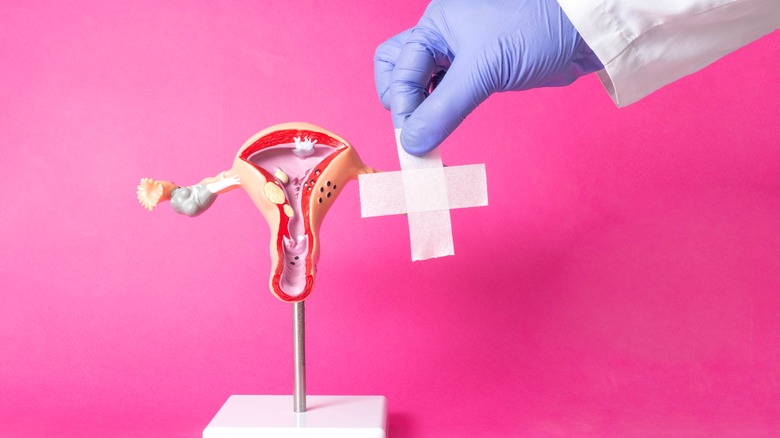Labiaplasty Is Becoming More Common - What Is It And What Are The Risks?
Since time immemorial, people with vaginas have been told that they should constantly reinvent themselves to conform to societal body standards that are impossible to attain. One is expected to be tall and thin (bonus points if you have an hourglass figure), have clear and fair skin, long, shiny locks, a button nose, high cheekbones, luscious lips, and straight, white teeth. You should also be hairless from the neck down and smell like roses all the time. These days, you're also apparently not supposed to show any camel-toe or bulge when wearing leggings or any tight clothing.
Millions of people have gone under the knife in an effort to attain these unrealistic standards, but in recent years, there's an increasing number of vagina owners who have taken it up a notch and elected for a procedure called labiaplasty to alter the appearance of their vulva and achieve what is called a "designer vagina." The International Journal of Impotence Research noted that there were nearly 200,000 labiaplasties performed by 2019, and this statistic has undoubtedly risen exponentially since then.
Labiaplasty, as the name implies, is a type of vulval surgery that involves reducing the size of the labia, or the skin surrounding the vagina. "A labiaplasty is most often performed on the labia minora, the folds closest to the clitoris, to create a 'tucked in' appearance," board-certified anti-aging expert Dr. Sofia Din told Healthline. And while this procedure is entering mainstream consciousness, it's not something people should take lightly.
How does labiaplasty work?
While labiaplasty is normally performed to make both the labia majora and labia minora (also called the "lips" of the vagina) appear symmetrical, per American Society of Plastic Surgeons, there are two ways to go about the procedure: trimming or wedging.
Trim labiaplasty is considered the "standard," and it involves removing the excess portion of the labia minora to make it proportionate to the labia majora. Many prefer this method as it usually also means getting rid of the labial regions with the most hyperpigmentation, which many people with vaginas take issue with, resulting in a "cleaner" appearance. A wedge labiaplasty, on the other hand, entails a more complex and invasive technique that cuts out triangle-shaped tissue from either side of the labia, creating a more drastic reduction in size compared to the trim technique. While it can leave the darker areas of the labia behind, one can end up with a vulva that appears tighter and tauter. In the plastic surgery space, this procedure is also referred to as the "Barbie."
Why do people get labiaplasty in the first place?
As it turns out, people don't get labiaplasty for purely aesthetic reasons. Per Hopkins Medicine, some elect to have the procedure as form of gender affirmation surgery, while others have it to alleviate the pain and discomfort they feel when they engage in sexual intercourse or strenuous physical activity. Women's Health points out that people whose labia minora is on the larger side tend to feel irritation during sex, which adversely affects their overall experience in the bedroom. "Just by reducing the size of the labia, sexual function might be improved, if anything, because you're not as worried about the tissue getting pulled or stretched during intercourse," Dr. Juliana Hansen, professor of surgery at the Oregon Health and Science University School of Medicine told the outlet.
It's worth noting, of course, that no two vaginas are the same, and there is certainly no "standard" when it comes to how vulvas should look. Some experts blame people's obsession with the appearance of their vulvas on pornography, but they assure that nine times out of them, there's no need for voluntarily mutilating your vulva. "There are certain anatomical landmarks that characterize normal genitalia, but there is no definition of what a normal appearance is," Dr. Leah Millheiser, assistant clinical professor at Stanford University Medical Center, shared with Refinery29. "The vulva can come in a variety of colors or hair patterns and labia of different sizes. I'm only concerned if there's new development of moles or discoloration, which could be an indicator of skin cancer."
What are the risks involved?
Just like how it goes with all surgeries, there are risks associated with labiaplasty that you should be wary of in case you want to go for this elective procedure. Dr. Paul Banwell, a plastic cosmetic surgeon, explained to HuffPost that there is always a risk of bleeding and infection, along with hematoma and scarring. The perineal region may also be susceptible to more bleeding, which could be exacerbated later during a vaginal childbirth.
Labiaplasty may also permanently change the way one experiences sex. Since a significant portion of the genitalia is removed, there is a chance that the pleasure one feels during intercourse will be reduced post-surgery. Some patients report feeling numbness in the area and experiencing vaginal dryness, both of which affect sexual sensation. And while it's rare, there's also a risk of damaging other parts of the vagina that are crucial in achieving sexual satisfaction, like the clitoris.
How much does it cost?
Labiaplasty is certainly not cheap, with the American Society for Aesthetic Plastic Surgery highlighting $3,593 as the estimated approximate cost for the procedure. Of course, price may vary depending on where a person gets the procedure, but in some states, the surgery cost can be as high as $8,000. And because it's an elective procedure, you may be hard-pressed trying to find an insurance company willing to cover it. Your options are to either pay out-of-pocket or find a surgeon that provides a payment plan to make the price more manageable.
Interestingly, a cheaper alternative for those looking for labia modification would be to opt for vaginal contouring or "vontouring," which also involves tightening of the labia. The procedure is less invasive than labiaplasty and easier on the pocket, with a session costing $300 a pop. The results are not as noticeable compared to a labiaplasty, but it may be more accessible. "It's not going to dramatically reshape your labia," OB-GYN Dr. Jennifer Gunter told The Daily Beast. "It's kind of like comparing a chemical peel to a facelift—they're totally different things."
What to know before getting labiaplasty
Before electing for labiaplasty, it's important to keep in mind that it is irreversible. Once a significant amount of tissue is taken out of the vulva, it can be difficult to recreate it, so one has to think about the decision carefully before pushing through.
As for the procedure itself, labiaplasty is an outpatient surgery that involves very little time commitment, usually only lasting one to two hours. Cleveland Clinic notes that it also involves the use of either local or general anesthesia depending on what is recommended by the surgeon, and that the removal of tissue requires a scalpel or laser. Recovery is also fairly quick and takes around two weeks for complete healing. However, patients are advised against engaging in rigorous physical activity (which includes sex) for up to 12 weeks post-procedure to avoid infection.
Unless your labia is deemed a "functional abnormality" and affects your day-to-day life, a labiaplasty is not necessary, Dr. Alexes Hazen, associate professor at the Hansjorg Wyss Department of Plastic Surgery, shared with Teen Vogue. Then again, at the end of the day, it's your body, so what you decide with it is ultimately up to you. If you think a labiaplasty will significantly improve your quality of life, it's a choice that is yours to make.





